The Current Culture of Dressage
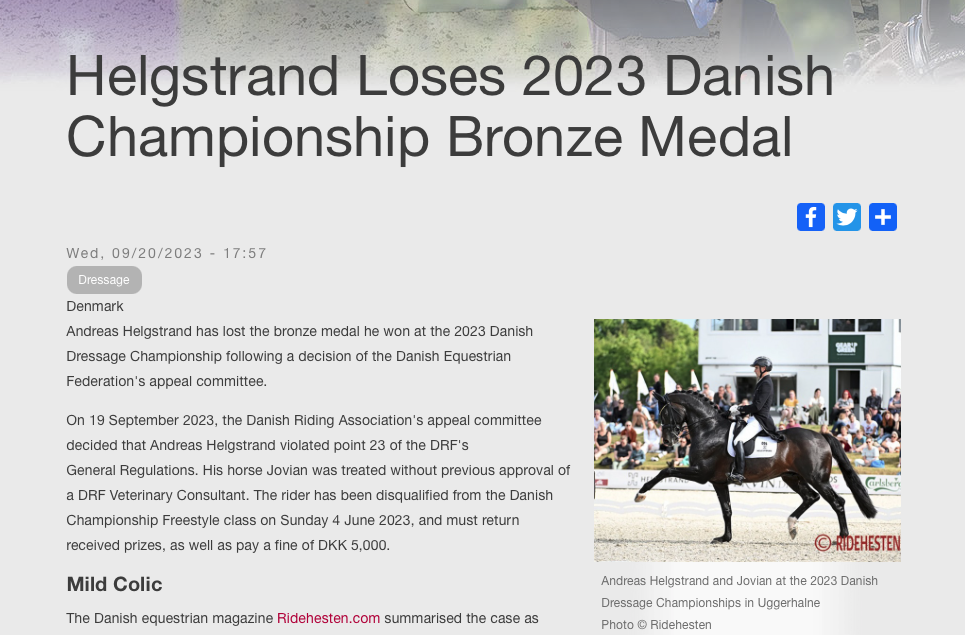
(graphic from eurodressage Wed, 09/20/2023 – 17:57)
- Paul Belasik looks at the disturbing ‘win at any cost’ mentality in the world of dressage…
Intentions and Outcomes
If you have ever served on a committee in any horse organization, you know it can be a thankless job. If you serve on a rules committee, you might find you need to be in some witness protection program where your identity remains unknown for fear of your safety. At the outset, I want to say I’m not interested in criticizing any rules committees. However, we have blood rules/drug rules/whip rules, spur and bit rules; they keep increasing in their numbers and specificity. They don’t seem to be working. The underlying question in the use of all equipment is, ‘in whose hands?’ I think the increasing restrictions point to a larger problem. They are symptoms of something systemic in dressage organizations and their current culture.
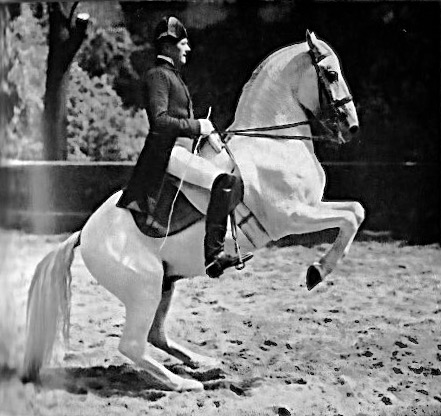
Spurs used by whom? The famous Oberbereiter Gottlieb Polak, one of my favorite riders. (From “My Dancing White Horses,” Alois Podhajsky.)
Outcomes
In sport, one outcome is whether you win or lose. In too many cases, the winning automatically validates your intentions, secures your status and can make you money. Your process gets glossed over, even when it is suspect. This kind of thinking is responsible for epidemic sophisticated cheating, and reflexive knee-jerk reactions of governing bodies to refine and make more and more rules to try to bridle people’s ambitions, especially because in our case it involves a beloved animal.
Why is this so hard to control? The simple answer is, the incentives to win are greater than the incentives not to cheat. Yet this is very complicated because the incentives to win are very complicated. They are linked into all the insecurities, biases and power struggles of people and society, and the mixed messages organizations give out.
Selling the Dream
Today when I look at dressage organizations, their business models resemble sport shoe corporations more and more. To sell dressage, they search the field for winning marquee athletes, riders, and horses. They provide publicity. They invite them to conduct symposiums, clinics, often when they are under qualified. The riders enhance their brand, they get more lessons, they sell more horses, endorse equipment, etc etc. The dressage organizations enhance their brand, they can increase membership, increase fees. It has become a complex, symbiotic commercial enterprise. Behind the scenes, sponsors, private equity firms, dressage organizations invest huge amounts of money to sell the dream to a widening pool of customers, more members, more saddle sales, more veterinary products, more horses, more real estate, more and more advertising.
I think many people think that dressage organizations don’t have much influence, they don’t have the budgets. What people fail to realize is that the currency of dressage organizations is the free labor pool of its members. When the FEI uses a word like sustainable, it makes you wonder how many horse events are sustainable. They often are only monetarily possible through the vast army of volunteers who provide the millions of dollars of free labor for activities which often really benefit only a few elite athletes and promoters.
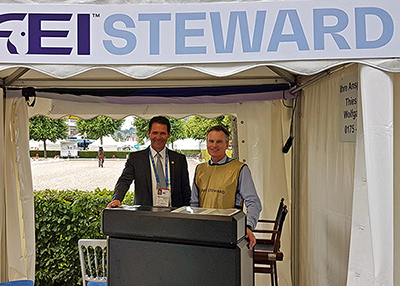
If you are just looking at the economics of an entertainment industry that essentially exists to make money, that would be one thing, but we have a very big problem here. The problem is that these equestrian organizations have distinct mission statements. The first sentence of the very short mission statement of the United States Dressage Federation says “dedication to education.” The FEI statement is littered with phrases like “horse first,” “fair and equal,” “ethical partnership with the horse,” “recognition of achievement,” “sustainable.” Nowhere do they say one word about a goal to promote and support dressage competition and the individuals who win them, the horse show industrial complex. The word ‘competition’ does not even come up. Winning is not synonymous with achievement.
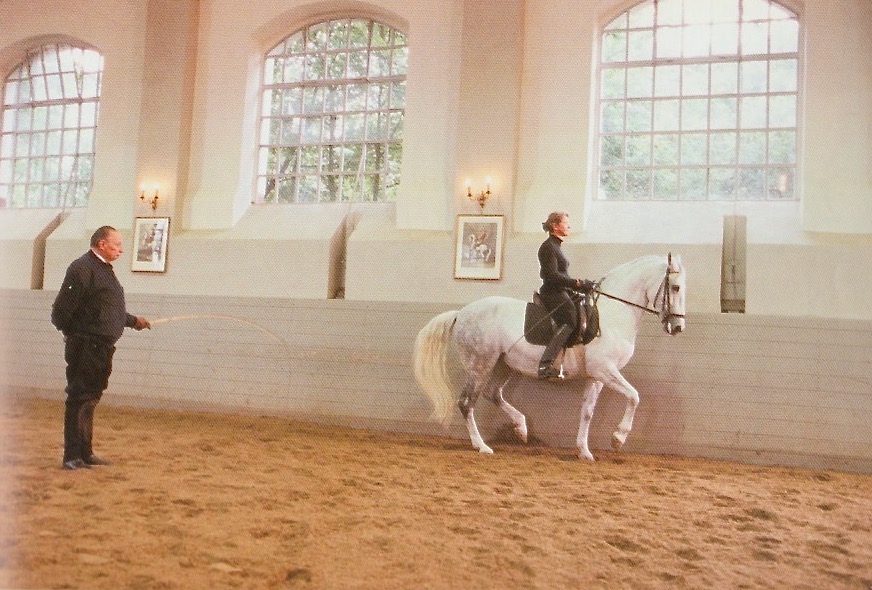
A whip in whose hands? Egon von Neindorff was, and still, is a worldwide inspiration who was always more about art than competition. Here the late master Egon von Neindorff and a student school piaffe.
(From “The Art of Classical Horsemanship,” Egon von Neindorff and Melissa Sims)
Culture
In organizations/corporations, the top executives/leaders are often not there because they made new widget for the company. They are not there because they are a wizard in the mailroom. They are often there because they are supposed to be the chief motivators of the company’s values. They are often gifted (for better or worse) promoters of the culture of that particular organization. That culture has consistency because it is not so much dependent on one individual’s ideas or personality, but by the mission statement, made at the founding of that group that will guide subsequent promotions.
Somehow as a group, the executives of dressage organizations are failing. They have abandoned their prospective mission statements, and have become embedded in this shadow culture of the horse show business, and advertently or inadvertently promote that culture, not the healthy, sustainable, fair, educational, horse-first culture of their mission statements.
Two Cultural Outcomes
I would like to introduce you to two cultural outcomes, two riders under twenty-five.
Rider #1
Interviewer: How have you been? I see you have been pretty busy lately?
Rider #1: It’s the time of year, yes there has been a rush of shows.
Interviewer: Do you have time to be a part of the daily care of your horses?
Rider #1: I’m afraid there just isn’t enough time. My father insists I keep trying for a business degree to have something to fall back on in case this horse thing doesn’t work out, so I have online work between horse shows. I pretty much just have to show up and ride.
Interviewer: How is your riding going?
Rider #1: Pretty well, we qualified for a selection but can’t seem to stay consistent in the 70’s. I love this horse but he may not be the one to get us to the top. The judges don’t seem to like his canter.
Interviewer: What’s the future look like?
Rider #1: Well, we have to do well at the next few shows, especially in Europe. My family and I are meeting with a new potential sponsor, my coach found this new horse in Denmark. You should see him, I’m really excited!
Interviewer: Why did you get in to riding?
Rider #1: My mother rode, but I always had this dream to make the team and to go to the Olympics, the whole idea of representing my country, standing on the podium. It just has always been there somehow.
Interviewer: I’ll be watching! Good to talk to you, best of luck.
Rider #1: Thanks!
Rider #2
Interviewer: How has your riding been going?
Rider #2: It’s been difficult, but getting better. It seemed to be all going wrong for a while, but for one of the first times lately, I feel it. I couldn’t quite fix it, but I saw how I was pushing us both too hard, especially in front of people. I was just pushing us right out of balance.
Interviewer: Why did you get into riding?
Rider #2: I’ve always loved animals. I had a chance to work for a very good horseman when I first started. I fell in love with riding. I can’t explain it. When I’m riding I can’t think of anything else, sometimes it’s the power, sometimes it’s the smoothness. I just like being around horses. Just brushing my horse can calm me down. His head starts lowering, his eyes half close, it makes me relax like something is coming back and forth through the brush. I don’t know – it’s really hard to explain, sorry.
Interviewer: No, no problem. What’s the future look like?
Rider #2: I have to learn to control my impulses. I am not helping my horse. I feel like I have to apologize to him, but when we are in sync it all seems to work. I can feel good all day about it. I want to do that more often!
Interviewer: I see you won this weekend?
Rider #2: Lucky I guess! We have a lot of work to do.
If these are two individual representations of cultural outcomes, which one seemed closer to the phrases and mission statements of ‘horse first,’ ‘partnership,’ ‘sustainable,’ ‘education,’ ‘achievement’?
Which one needs less supervision, knowingly or unknowingly from rules which essentially all boil down to checks on ambition and abuse?
Good outcomes are a result of unflinching scrutiny of intention, admitting failures and not resisting change. Dressage organizations have to look at their outcomes. Executives have to be bolder about representing and promoting the culture of their respective mission statements. They need to serve their memberships more than having the memberships serve the horse show industry. With proper leadership, the trajectory can be turned around. It has to start with education.
Antoine de Pluvinel was one of the greatest promoters of the culture of classical dressage. With the morality of the youth in tatters in France in the 1600’s, Pluvinel pleaded with the King of France for more riding academies to promote education. Pluvinel explained to the King that the art and science of horsemanship is important because it is “the most beautiful and the most necessary of all exercises, not only for the body, but for the mind and it obliges man to live soberly and orderly. Thus in keeping with the ideals of the Renaissance and Greek antiquity, horsemanship was not merely an exercise which shapes an individual’s physical prowess, but also nurtures and reveals an individual’s judgement, honor, courage, sense of bienséance and even virtue.”*
He reminds the King, “Thus your majesty can see quite clearly how useful this beautiful exercise is to the mind since it instructs and accustoms it to perform with clarity and order all these functions amid noise, worry, agitation and the fear of constant danger”.* When the King wants to know the difference between a graceful horseman and a judicious horseman, Pluvinel cleverly shows the difference between surface knowledge and and a true master trainer and rider.
Pluvinel’s discourse is not a collection of clever antiques. His advice is more current than ever. We need more Pluvinels now more than ever. We need to be reminded of what is really important about dressage.
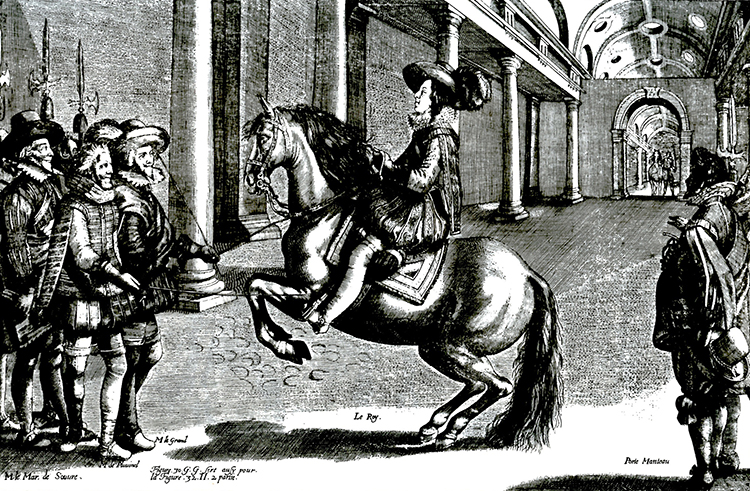
*Pluvinel, Antoine de. “Le Maneige Royal.” Trans. Hilda Nelson. J.A. Allen, 1989. London

Super. So true
This is a very important editorial!!
Are you going to put it on your FB page so it can be shared?
yes
Si, totalmente d’accordo… Risolvere i problemi del dressage solo in questa ottica… Viva Pluvinel!!!
I have been riding for about 60 years, last week I finally grasped ‘balance’ and having to apply it to every step until my horse carries himself. What a revelation! I am very excited. My coach is a fabulous teacher, rides beautifully, and has no Olympic aspirations.
Cet éditorial est courageux… Il remet au centre du village le cheval.
As always another insightful article. Please keep them coming.